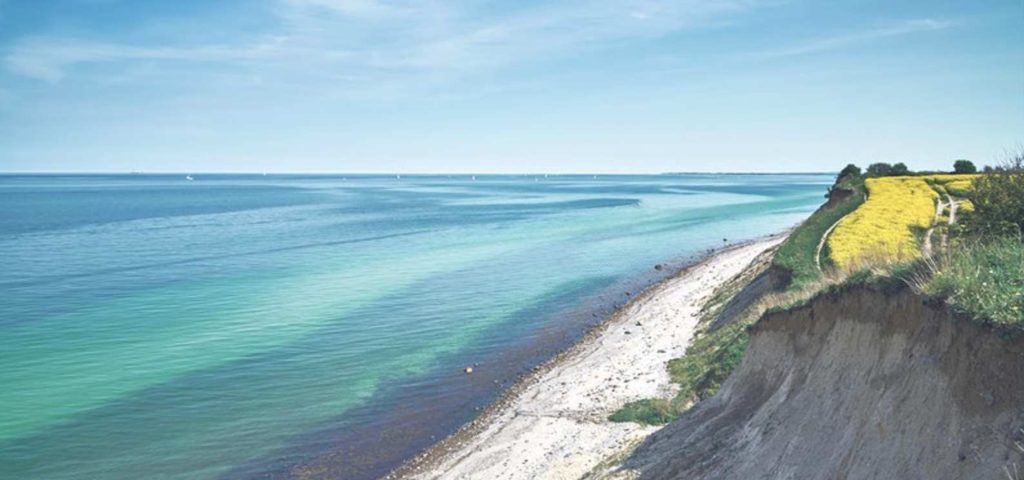The Baltic Sea is between the Scandinavian Peninsula and northern Europe. Because it’s relatively isolated and connected only to the North Sea, people think there are no sharks in the Baltic Ocean. But it’s not true.
There are 18 species of sharks in the Baltic Sea. The most common shark species in the Baltic Sea are the Spurdog, Small-Spotted Catsharks, Blue Sharks, Porbeagle Sharks, Blackmouth Catshark, Bluntnose Sixgill Sharks, Basking Sharks, Oceanic Whitetip Sharks, and even Smooth Hammerheads.
Considering all cartilaginous fishes (sharks and closely related skates, rays, and chimaeras), there are 31 species in total. In this article, you’ll find out what are all these 31 species (and the 18 sharks) on the Baltic Sea. However, shark attacks in this region are almost non-existent (I’ve looked at every possible database and only found two incidents, with no casualties).
Keep reading to learn all about sharks in the Baltic Sea.
Are There Sharks In The Baltic Sea?

For some reason, people tend to think that there are no sharks in the Baltic Sea. It’s not true, as there are 31 species of cartilaginous fishes in general (sharks, skates, rays and chimaeras), and sharks are the majority of them in the Baltic.
In total, 18 species of shark have been recorded in the Baltic Sea. Still, shark attacks are almost inexistent in this region. The most common species are:
- Spurdog Shark
- Small-Spotted Catshark
- Blue Shark
- Porbeagle Shark
- Blackmouth Catshark / Blackmouth Dogfish
- Bluntnose Sixgill Shark
- Angel Shark
- Basking Shark
- Oceanic Whitetip Shark
- Smooth Hammerhead Shark
These are the most common species of shark in this arm of the ocean, found primarily in the Western Baltic and, as confirmed by Shark Alliance.
“The most common species of shark in the Baltic are the spurdog (spiny dogfish), the thorny skate, and the small-spotted catshark. Also found are blue and porbeagle sharks, blackmouth dogfish, thornback rays and bluntnose sixgill sharks and the “common” varieties of skate, stingray and angel shark. Even the immense, filter-feeding basking shark, which can grow up to 10m long, is found here. There are single records of the wide-ranging oceanic whitetip shark (SwedishGullmarsfjorden in 2004) and the smooth hammerhead (Danish Kattegat in 1937).”
Sharks In The Baltic – Shark Alliance
Related Article: Are There Sharks In Denmark? (New Research)
Sharks In The Baltic Sea: 18 Species
The Baltic Sea is the largest semi-enclosed brackish body of water in the world. Mostly surrounded by land, it’s only connected to the North Sea (and from there, to the north Atlantic).
It’s bordered by nine countries: Denmark, Sweden, Finland, Russia, Estonia, Latvia, Lithuania, Poland, and Germany. Norway is situated on the transitional waters of the Skagerrak, one of the narrow straits connecting the Baltic to the North Sea.
- Total Number of Shark Species In The Baltic Sea: 18
- Number of Cartilaginous Fishes Species In The Baltic: 31
- Most Frequently Seen: Spurdog / Small-Spotted Catshark
- Most Dangerous/Aggressive Species: Oceanic Whitetip Shark
- Biggest Sharks Found In The Baltic: Basking Sharks
A sad indicator about sharks in the Baltic is that eight out of the 18 Baltic sharks (44%) are considered threatened with extinction. The Spurdog, Porbeagle, Common skate, and Angelshark are considered critically endangered. In the following table, you can find a detailed description of all the 31 species of cartilaginous fishes in the Baltic Sea (including 18 sharks).
| Species | Scientific Name | Max Size | Aggressiveness |
| Thresher Shark | Alopias vulpinus | Up to 7.6m (25 ft) | Not Aggressive (Harmless) |
| Starry or Thorny Skate | Amblyraja radiata | Up to 1 m (3.4 ft) | Not Aggressive (Non-Poisonous) |
| Oceanic Whitetip Shark | Carcharhinus longimanus | Up to 4 m (13 ft) | Very Aggressive (Dangerous) |
| Basking shark | Cetorhinus maximus | Up to 12 m (40 ft) | Not Aggressive (Harmless) |
| Ratfish or Ghost Shark | Chimaera monstrosa | Up to 1.2 m (49 in) | Not Aggressive (Harmless) |
| Common stingray | Dasyastis pastinaca | Up to 2.5 m (8.2 ft) | Not Aggressive (Poisonous | Non-Fatal) |
| Common skate, blue ray | Dipturus batis | Up to 2.8 m (9.2 ft) | Not Aggressive (Harmless | Non-Poisonous) |
| Sailray | Dipturus linteus | Up to 1.1 m (3.6 ft) | Not Aggressive (Harmless | Non-Poisonous) |
| Longnose skate | Dipturus oxyrinchus | Up to 1.5 m (4.9 ft) | Not Aggressive (Harmless | Non-Poisonous) |
| Bramble shark | Echinorhinus brucus | Up to 3.1 m (10 ft) | Not Aggressive (Harmless) |
| Velvet belly shark | Etmopterus spinax | Up to 45 cm (18 in) | Not Aggressive (Harmless) |
| Tope, School shark | Galeorhinus galeus | Up to 1.9 m (6.3 ft) | Not Aggressive (Harmless) |
| Blackmouth dogfish | Galeus melastomus | Up to 0.75 cm (29 in) | Not Aggressive (Harmless) |
| Bluntnose sixgill shark | Hexanchus griseus | Up to 4.82 m (16 ft) | Not Aggressive (Poisonous to eat. Ref: link) |
| Porbeagle | Lamna nasus | Up to 3.6 m (12 ft) | Not Aggressive (Potentially Dangerous) |
| Sandy ray | Leucoraja circularis | Up to 1.2 m (49 in) | Not Aggressive (Harmless) |
| Shagreen ray | Leucoraja fullonica | Up to 1.2 m (49 in) | Not Aggressive (Harmless) |
| Starry smoothhound | Mustelus asterias | Up to 1.8 m (5.9 ft) | Not Aggressive (Harmless) |
| Angular rough shark | Oxynotus centrina | Up to 1.5 m (4.9 ft) | Not Aggressive (Harmless) |
| Blue shark | Prionace glauca | Up to 4 m (13 ft) | Not Aggressive (Curious, Approach Humans) |
| Thornback ray | Raja clavata | Up to 1 m (3.4 ft) | Not Aggressive (Harmless) |
| Spotted ray | Raja montagui | Up to 80 cm (31 in) | Not Aggressive (Harmless) |
| Round ray | Rajella fyllae | Up to 55 cm (21 in) | Not Aggressive (Harmless) |
| Small-Spotted Catshark | Scyliorhinus canicula | Up to 1 m (3.4 ft) | Not Aggressive (Harmless) |
| Nursehound | Scyliorhinus stellaris | Up to 1.5 m (4.9 ft) | Not Aggressive (Harmless) |
| Greenland shark | Somniosus microcephalus | Up to 4.27 m (14 ft) | Not Aggressive (Poisonous to eat. Ref: link) |
| Smooth Hammerhead | Sphyrna zygaena | Up to 5 m (16 ft) | Aggressive (Potentially Dangerous) |
| Spurdog | Squalus acanthias | Up to 1.5 m (4.9 ft) | Not Aggressive (Venomous) |
| Common angel shark | Squatina squatina | Up to 1.8 m (5.9 ft) | Not Aggressive (Venomous) |
| Marbled electric ray | Torpedo marmorata | Up to 1 m (3.4 ft) | Not Aggressive (Dangerous | Electric Shock) |
| Electric ray | Torpedo nobiliana | Up to 1.8 m (5.9 ft) | Not Aggressive (Dangerous | Electric Shock) |
Related Article: Are There Sharks In Rio De Janeiro? (Rio Sharks Guide)
Shark Attacks In The Baltic Sea
I’ve looked at every possible database and could only find two shark incidents in the Baltic Sea. There is data from one attack in Sweden, and one in Finland, listed by ISAF, but detailed information is not available.
| Date | Area | Location | Activity | Incident Type | Fatal? |
|---|---|---|---|---|---|
| Jan 1 1755 | Sweden | Bohuslän | Fishermen | Unprovoked | No |
| Unknown | Finland | – | – | Unprovoked | No |
Related Article: Are There Sharks In The English Channel? (Full Guide)
Related Questions
Are there shark attacks in the Baltic Sea? There are 18 species of shark in the Baltic Sea, and the most common are the Spurdog, Small-Spotted Catsharks, Blue Sharks, Porbeagle Sharks, Blackmouth Catshark, Bluntnose Sixgill Sharks, Basking Sharks, Oceanic Whitetip Sharks, and Smooth Hammerheads.
Are there sharks in the Baltic Sea in Sweden? There are 18 species of sharks that have already been recorded in the Baltic Sea in Sweden. However, shark attacks are very rare. There’s only one register of an unprovoked shark attack in Sweden, non-fatal, back in 1755.
Does Baltic Sea have great white sharks? There is no record of Great White sharks in the Baltic Sea. However, it’s not impossible for there to have been a Great White Shark in the Baltic. As the Baltic is connected to the North Sea, and from them to North Atlantic, where Great Whites are present.
Sources
- Global Shark Attack File (GSAF): https://www.sharkattackfile.net/
- Florida Museum: https://www.floridamuseum.ufl.edu/
- International Shark Attack File (ISAF): https://www.floridamuseum.ufl.edu/shark-attacks/
- Sharks In The Baltic (Shark Alliance): https://www.sharkadvocates.org/sharks_in_the_baltic.pdf
- Fishbase: https://www.fishbase.us/
